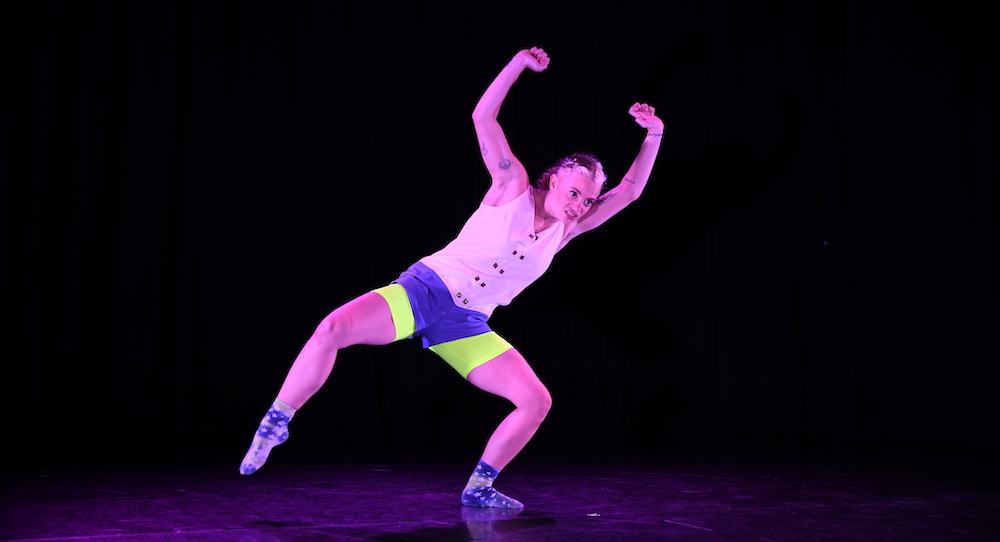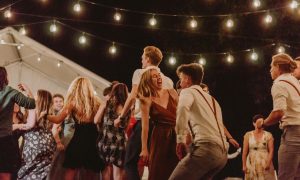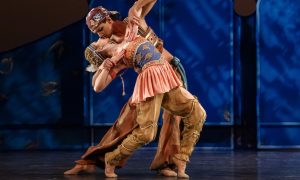Arts On Site, New York, NY.
October 1, 2023.
mignolo dance presented a diverse evening of dance works at Arts On Site on October 1. Six live works and one screendance created imaginative worlds of movement based on concrete ideas and feelings.
Charly and Eriel Santagado’s jovial quartet Arcadia opened the program, danced by the choreographers alongside Paige Bodnar and Aanyse Pettiford-Chandler. The dancers embodied mythological woodland creatures through explosive and spirited movement, drawing inspiration from the Greek god Pan and his homeland Arcadia. Mignolo’s “translation” style was evident as each movement – no matter how billowing or quirky – struck each musical note with precision. The specificity of the choreography did not detract from the dance’s playfulness; the audience was regularly transported into moments of humor, happiness and harmony. In one scene, notable for its relative quiet, the dancers stood in a vertical line, inching their way downstage through rocking steps and bourrées. As they approached, they carved different shapes with their arms and alternated positions in the line. In its few short minutes, the dance made the audience want to jump, prance, and fly alongside the dancers.
Ishita Mili’s FORM featured six dancers sculpting the space with their individual bodies and shifting formations. According to Mili, “FORM [examines] how historical and codified dance forms police our bodies, and how bodily shapes imply social norms.” Mili’s movement vocabulary drew from many dance forms, including Bharatanatyam, contemporary and hip hop. While the first section featured a mostly standing group unison, the second section introduced a softer, heavier feeling as the artists melted onto their knees. Upon rising again, they faced the audience and swayed their hips, articulating their arms with intensity and confidence. Their precise execution, and weaving of individual styles and unified movements emphasized the importance of bodily freedom and its relation to collectivity.
Dream Caused by the Flight of a Bee Around a Pomegranate a Second Before Awakening, inspired by Salvador Dali’s painting of the same name, was choreographed and danced by Charly Santagado. This solo is an exemplary translation of both visual art and music – played by The Twiolins – into movement. While Charly continually matched each musical note with specificity in her body, she brilliantly captured the energy of Dali’s painting. The painting and dance both contained contrasting moments of ferocity and lull – and a final moment of nearly being engulfed by nothingness.
In Adderall, described in the program as “a day in the life of [Eriel’s] ADHD brain,” dancer and choreographer Eriel suffused the space with vibrant movements, facial expressions, costuming and lighting to expose ADHD’s highs and lows, ins and outs, colors and shades. She danced to an original sound score by herself and Charly, composed of dissonant piano, drumming and emphatic nonsense vocalizations. She tightrope walked to the clicking of a tongue, and collapsed to the floor only to immediately launch herself into the next movement. She pursed her lips, stretched her body in a yawn, and broke out into an absurd dance phrase. The solo was an inside peek at her dazzlingly creative mind.
Conjoined, a dance film, was both entertaining and enlightening. With stunning videography by Brian Curry and choreography and performance by Charly and Eriel Santagado, the film depicted the story of conjoined twin sisters. Charly and Eriel Santagado danced together inside of one large, long skirt, which was red in the beginning of the film, later shed to a tan color. The audience followed the sisters’ journey within the realms of the entertainment industry, and how they navigated their physical capabilities. They danced together on a stage in a gorgeous theater, executing impressive feats such as high kicks and tumbles across the stage, all the while being physically connected. This joyous opening scene faded into a heavier atmosphere, where the sisters expressed their suffering through how they partner one another, their expressions anguished. This ultimately morphed into a slideshow-like transition set to My Chemical Romance’s eerily playful song titled “Blood.” The scenes flickered between different backgrounds, the sisters at times surrounded by the red skirt only to be wearing the tan skirt at the next blink. Concluding this scene, Charly clinked an imaginary glass with Eriel and collapsed to the floor, disconnected from their conjoined stage. She left Eriel – outside of the skirt – to stagger through a spotlight off of the stage and into the theater’s house, physically alone for the first time in her life. She appeared wounded. The film depicted the unconditional love that the sisters had for one another, flashing back to happy memories they shared while preparing for a performance, while also demonstrating the possibility of freedom that Eriel felt once she became independent.
Visits to St. Elizabeths, a quartet by Charly Santagado in collaboration with her dancers, continually created dark atmospheres. Erika Fawcett, Karolina Holmstrom, Charly Santagado and Eriel Santagado chillingly captured the dance’s subject matter. The dance, noted by Charly, is a, “word-for-word dance translation of the poem of the same name by Elizabeth Bishop,” which details Ezra Pound’s life in a sanatorium. Charly’s voice served as the sound score, reciting Bishop’s poem and instilling the manic repetitions through voice and the dancers’ movements. Each vocal and dance phrase carried whispers; were subtle, yet reverberating. The dancers layered upon one another in phrase material – some taking pauses in statues shaped like “The House of Bedlam,” while others swept through the space – as the poem’s lyrics stacked upon each other. Equally powerful was when the quartet met up in unison, creating shapes of houses and the sea with their arms, shifting through the space together to the poem’s haunting score. Repeated gestures that corresponded with specific lines of the poem were visible, such as “The House of Bedlam,” and “newspaper hats,” which were both raised arm gestures above the dancers’ heads.
A video of a volcanic eruption seized the audience’s attention in the program’s final work: Eruption/Regenesis by Charly Santagado. A singular dancer – Eriel Santagado – briefly treaded through a barren stage, only to erupt into fierce, frenzied movement herself. The remaining seven cast members fizzled into the space like the volcano’s ashen clouds, billowing with energy while darting movements propelled them forward. Eruption/Regenesis – danced by Bailey Benoot, Paige Bodnar, Erika Fawcett, Ishita Mili, Louisa Miller, Aanyse Pettiford-Chandler, Charly Santagado and Eriel Santagado, explored what it means to face natural disasters, along with any of life’s most difficult challenges. The dancers displayed shock, panic, grief, anger, acceptance and a desire to help one another through each stage of the calamity. Original music by Daniel Gall created an emotional atmosphere. Some dancers sat on the floor and rocked from side to side while others swirled through standing movement phrases, at times creating shapes that matched images of the eruption’s video behind them. Their costumes were tattered pedestrian clothes, and there were moments where the cast would intentionally cough during a frenzied scene of dancing. Another striking image involved all eight dancers collapsed on the stage. They appeared frozen in time, as their bodies held still in contorted positions; some appeared to be praying, while others were covering their faces. Eventually standing up after a dynamic solo by Charly Santagado, the cast reemerged in a celebratory dance full of jumps and runs. It was a send-off to the audience of new life and growth.
By Kristen Hedberg of Dance Informa.















